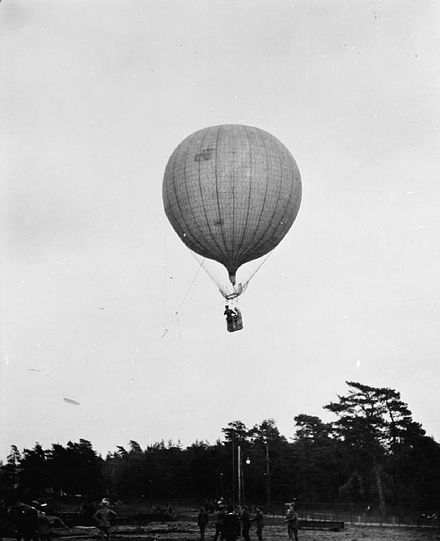Helicopter platoons distributed – You take what you have
In 1985 AF 2, or the Östgöta Army Aviation battalion, was formed, equipped with several Hkp 5B helicopters. It had namely been decided that the Hkp 5B would replace the Sk 61 Bulldog aircraft in the role of observation platform and artillery fire direction. So a little more than 25 years after the US Army had dismissed the Hughes 269 as an observation helicopter the Swedish Army did the opposite. Part of the explanation for this was that there were plenty of spare parts for the helicopters, and that within Sweden there were over 40 civilian-registered machines, which could be called up for military service in the case of war. Such had not been the case during the trials of the Hkp 5A in the 1960s.

Among the first military aviators were fire directors who with the aid of balloons could direct artillery fire, without the gunners being able to see enemy positions themselves. The Hkp 5B was a distant successor to these balloons. Source: Wikimedia
Instead of acquiring a helicopter on the basis of the requirements that could be defined for a fire control helicopter, the existing Hkp 5B was adopted, with the necessary consequent platoons formed and organised.
This helicopter was regarded as relatively battle-worthy, and within the spread out helicopter platoons there were the necessary resources for repair, warming up and charging required in the field. The greatest problem was engine starting in cold weather, if the engine had been allowed to get too cold, but this problem had already been identified in the case of the Hkp 5A. On the other hand, few special tools were needed for working on the Hkp 5, for which the mechanics out in the field were thankful. In addition the helicopter was surprisingly robust, an advantage as the pilots were conscripts. However for every flying hour about 3 hours of ground maintenance was required, which was rather a lot.
The distributed helicopter platoons were in the first place intended to co-operate with artillery units, each platoon having six helicopters. Each unit was expected to be able to fly 30 hours per day, and have the ability if necessary to double this for short periods of time. That would definitely have put a lot of pressure on the crews. In summer time, especially while hovering, temperatures in the tiny cabin could reach up to 40⁰C, in other words it was like a greenhouse. This is why the helicopter was given the nickname ”The flying pisshouse”.
The conscripted pilots were from the start forced to take into account that the these helicopters were not very powerful, which was not made any better by all the modifications that were introduced in order to fulfil its role as an observation helicopter.
Not good, but good enough
As an afterthought it can seem a little strange that the Hkp 5 was chosen for a task for which in the 1950s it had been considered unsuitable. However one must bear in mind that Sweden and the USA had then and still have completely different resources. Purchasing a helicopter specifically fot fire control and observation was economically unthinkable. As a small country, Sweden was and is obliged to husband its resources with smart thinking, and the Hkp 5 was not the only flying machine that had to fulfil two roles. The Sk 61 Bulldog had served as both a training aircraft and, in the event of hostilities, an artillery aircraft.. The SAAB Sk 60 jet trainer would in the event of war be used as an attack aircraft. Thus using the Hkp 5 as an observation helicopter was a way to extract as much as possible from Sweden’s limited resources.
The Hkp 5 was not the perfect military observation helicopter. Some would say that it wasn’t even much good as an observation helicopter at all. However it was good enough to do the job, and was available in sufficient numbers. In today’s world, where the idea is that only the most modern and high-tech equipment could win wars (without taking into account the undenying economics and not least logistics) this may seem strange and perhaps completely idiotic. But in its way, the advancing use of drones is showing that it is not always the most modern and expensive that it best. When fighting began in the Ukraine it turned out that relatively simple and unarmed Russian drones were very effective in their role as fire observers for the artillery. Besides this, there were plenty of them and they served their purpose.
In battle in Syria and Iraq the IS fighters were using relatively simple civilian drones modified to carry hand grenades and similar explosives as attack weapons. This is light years away from USA’s heavily armed drones in terms of both range, advanced technology and armament. Nevertheless they succeeded in alarming soldiers at the front, and on at least one occasion a really advanced and expensive Patriot anti-missile system was used to shoot down an IS drone. The drone was pulverised, but an American general later remarked in a speech that a Patriot was hardly the best weapon to use. The cost of the basic drone was only a small fraction of the advanced technology anti-missile rocket, so in purely economic terms it was in fact the drone and the IS who won, since its opposing missile was so much more expensive to produce.
Today it is probable that it will be drones that fulfil the function of observation helicopters and aircraft. Both pilots and fire controllers could then sit at a safe distance while the radio-controlled drones kept an eye on the enemy.
